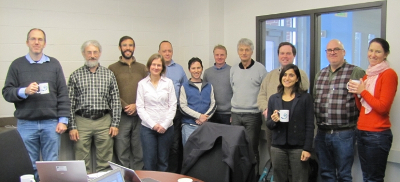Study Shows Large Variability in Abundance of Viruses That Infect Ocean Microorganisms
January 25, 2016

|
| The new study was initiated as part of the NIMBioS Working Group on Ocean Viral Dynamics, shown here at its last meeting in January 2014. Credit: NIMBioS. |
Viruses infect more than humans or plants. For microorganisms in the oceans - including those that capture half of the carbon taken out of the atmosphere every day - viruses are a major threat. But a paper to be published January 25 in the journal Nature Microbiology shows that there's much less certainty about the size of these viral populations than scientists had long believed.
Collecting and re-examining more than 5,600 estimates of ocean microbial cell and virus populations recorded over the past 25 years, researchers have found that viral populations vary dramatically from location to location, and at differing depths in the sea. The study highlights another source of uncertainty governing climate models and other biogeochemical measures.
"What was surprising was that there was not a constant relationship, as people had assumed, between the number of microbial cells and the number of viruses," said Joshua Weitz, an associate professor in the School of Biology at the Georgia Institute of Technology and one of the paper's two senior co-authors. "Because viruses are parasites, it was assumed that their number would vary linearly with the number of microbes. We found that the ratio does not remain constant, but decreases systematically as the number of microbes increases."
The research, which involved authors from 14 different institutions, was initiated as part of the NIMBioS Working Group on Ocean Viral Dynamics. Weitz co-organized the working group, along with lead co-author Steven Wilhelm, a professor of microbiology at the University of Tennessee, Knoxville. The research was completed with additional support from the Burroughs Wellcome Fund and the Simons Foundation.
In the datasets examined by the researchers, the ratio of viruses to microbes varied from approximately 1 to 1 and 150 to 1 in surface waters, and from 5 to 1 and 75 to 1 in the deeper ocean. For years, scientists had utilized a baseline ratio of 10 to 1 - ten times more viruses than microbes - which may not adequately represent conditions in many marine ecosystems.
"A marine environment with 100-fold more viruses than microbes may have very different rates of microbial recycling than an environment with far fewer viruses," said Weitz. "Our study begins to challenge the notion of a uniform ecosystem role for viruses."
A key target for viruses are cyanobacteria - marine microorganisms that obtain their energy through photosynthesis in a process that takes carbon out of the atmosphere. What happens to the carbon these tiny organisms remove may be determined by whether they are eaten by larger grazing creatures - or die from viral infections.
When these cyanobacteria die from infections, their carbon is likely to remain in the top of the water column, where it can nourish other microorganisms. If they are eaten by larger creatures, their carbon is likely to sink into the deeper ocean as the grazers die or excrete the carbon in in their feces.
"Viruses have a role in shunting some of the carbon away from the deep ocean and keeping it in the surface ocean," said Wilhelm. "Quantifying the strength of the viral shunt remains a vital issue."
Influenza and measles come to mind when most people think of viruses, but the bulk of world's viruses actually infect microorganisms. Estimates suggest that a single liter of seawater typically contain more than ten billion viruses.
To better understand this population, the researchers conducted a meta-analysis of the microbial and virus abundance data that had been collected over multiple decades, including datasets collected by many of the co-authors whose laboratories are based in the United States, Canada and Europe. The data had been obtained using a variety of techniques, including epifluorescence microscopy and flow cytometry.
By combining data collected by 11 different research groups, the researchers created a big picture from many smaller ones. The statistical relationships between viruses and microbial cells, analyzed by first-author Charles Wigington from Georgia Tech and second-author Derek Sonderegger from Northern Arizona University, show the range of variation.
The available data provides information about the abundance of viral particles, not their diversity. Viruses are selective in the microbes they target, meaning the true rates of infection require a renewed focus on virus-microbe infection networks.
"Future research should focus on examining the relationship between ocean microorganisms and viruses at the scale of relevant interactions," said Weitz, "More ocean surveys are needed to fill in the many blanks for this critical part of the carbon cycle. Indeed, virus infections of microbes could change the flux of carbon and nutrients on a global scale."
Citation: Wigington CH et al. 2016. Re-examination of the relationship between marine virus and microbial cell abundances. Nature Microbiology. [Online]
Media Coverage Highlights
Georgia Tech College of Sciences: Study shows large variability in abundance of viruses that infect ocean microorganisms
#
The National Institute for Mathematical and Biological Synthesis is an NSF-supported center that brings together researchers from around the world to collaborate across disciplinary boundaries to investigate solutions to basic and applied problems in the life sciences.
CONTACT:
Catherine Crawley, NIMBioS, +1-865-974-9350, ccrawley@nimbios.org
NIMBioS
1122 Volunteer Blvd., Suite 106
University of Tennessee
Knoxville,
TN 37996-3410
PH: (865) 974-9334
FAX: (865) 974-9461
Contact NIMBioS


